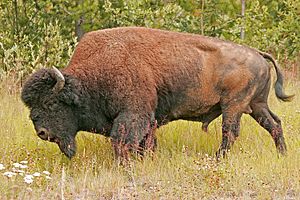Hay-Zama Lakes facts for kids
Quick facts for kids Hay-Zama Lakes |
|
|---|---|
|
IUCN Category Ib (Wilderness Area)
|
|
| Lua error in Module:Location_map at line 420: attempt to index field 'wikibase' (a nil value). | |
| Location | Mackenzie County, Alberta, Canada |
| Nearest city | High Level, Alberta |
| Area | 586 km2 (226 sq mi) |
| Designated: | 24 May 1982 |
| Reference #: | 242 |
Hay-Zama Lakes is a huge natural area in northwestern Alberta, Canada. It covers about 586-square-kilometre (226 sq mi) of land. This special place is known for its many lakes and marshy lands, called wetlands.
It was named a Ramsar wetland of international importance in 1982. This means it's a very important wetland recognized around the world. It's also an Important Bird Area, which means lots of birds live or visit here. Experts say it's one of the biggest marshy areas with grass-like plants (sedges) in western North America.
Hay-Zama Lakes is about 100 km (62 mi) west of the town of High Level. It's also about 140 kilometres (87 mi) from the border with the Northwest Territories. This area is so special that it's being considered to become a World Heritage Site. This would make it a place recognized by the whole world for its unique value.
Hay-Zama Lakes is even connected to a similar natural area far away. It is twinned with Dalai Lake National Nature Reserve in Inner Mongolia, China. This twinning helps share knowledge about protecting these important wetlands.
Contents
Geography of Hay-Zama Lakes
This area is mostly a flat, low-lying wetland system. It has many freshwater lakes that are rich in nutrients, called eutrophic lakes. It also includes the areas around the Peace River that flood often, and its river deltas. The land here is about 320 metres (1,050 ft) above sea level.
The amount of water in the lakes changes a lot. This depends on the seasons and how much rain or snow falls each year. Water flowing in from the Hay River greatly affects how big and deep the lakes are. The largest lake in this system is Zama Lake.
Protecting the Land
Since the 1960s, there has been some oil and natural gas activity in this area. This has caused some changes to the landscape around the wetlands. However, there's good news for the future of Hay-Zama Lakes.
The Dene Tha' First Nation, who are the Indigenous people of this land, made an agreement with the oil and gas companies. This agreement means no new wells will be built starting in 2007. Also, all oil and gas activities in the wetland complex will stop completely by 2017. This helps protect this important natural area for the future.
Amazing Animals of Hay-Zama Lakes
Hay-Zama Lakes is a very important place for many animals, especially birds.
Birds and Their Journeys
This wetland complex is a busy stop for many migratory birds. They visit during their long journeys in spring and fall. Imagine seeing over 250,000 ducks and 177,000 geese all at once during their migration!
The area is located on three major paths that waterfowl use to fly across North America. These paths are called Pacific, Central, and Mississippi flyways. Because of this, Hay-Zama Lakes is a crucial place for many kinds of waterfowl to rest, feed, and even molt their feathers. This is the main reason it was named a Ramsar site.
Wood Bison: A Comeback Story
Hay-Zama Lakes is the only place in Alberta where Wood Bison have been brought back into the wild. These large animals love to eat the sedges and grasses that grow naturally in the area during winter.
In 1984, a group of 24 bison were moved here from Elk Island National Park. Since then, their population has grown steadily to about 700 members! However, these bison sometimes follow old roads made for oil and gas work. This can lead them towards the town of High Level, where they are attracted to roadside grasses.
There was a concern about these bison meeting other bison from Wood Buffalo National Park. Some bison from that park carry diseases like brucellosis or tuberculosis. To prevent these diseases from spreading to the healthy Hay-Zama herd, special permits were given to Dene Tha' hunters. These permits allowed them to guide or, if necessary, cull straying animals. This helps keep the Hay-Zama bison herd healthy and strong.


